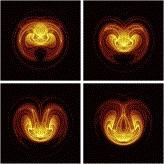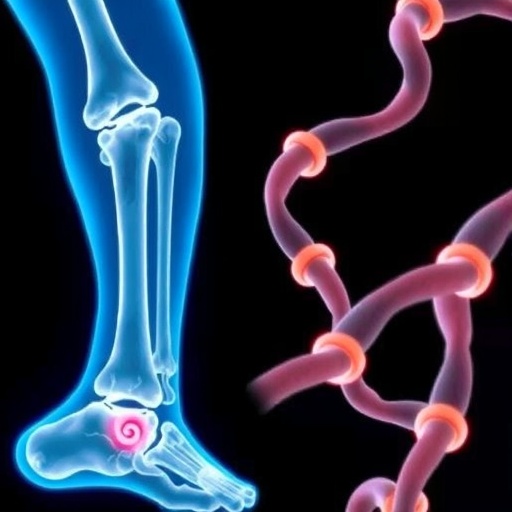Researchers will present a wide range of climate work during the APS 2020 March Meeting

Credit: Reproduced from Chekroun, Simmonet, and Ghil (Physica D, 2011)
DENVER, COLO., FEBRUARY 28, 2020 — Climate change is one of the most daunting challenges facing the planet and humanity, so scientists around the globe are working to provide more clarity about the scale of the problem and searching for solutions.
At the 2020 American Physical Society March Meeting in Denver, researchers will share their climate work, including: decoding the climate system’s behavior, a new approach to climate modeling, a novel material that can morph from cornstarch to industrial plastic and then back into an edible again, using satellite imaging to promote high-yield organic farming, and making the case for innovation via nuclear sources to create cheaper carbon-free energy.
Decoding the Climate System’s Dynamic, Complex Behavior
The climate system is dynamic, with complex behavior that includes oscillatory modes that are more or less regular, such as the El Niño-Southern Oscillation (ENSO), as well as highly irregular, noisy phenomena like the weather systems of mid-latitudes. How does changing atmospheric composition affect this complex behavior? What about changes in the amplitude and frequency of extreme events like hurricanes, floods, or droughts?
Michael Ghil, physicist and distinguished research professor at the University of California, Los Angeles, will present a new framework for studying the behavior of the climate system’s complex dynamics when subjected to anthropogenic effects, and how these effects may modify its key features.
“These key features include stationary states that don’t change at all in time, pure oscillations whose periodic behavior changes in relatively simple ways, and more complicated entities like the ‘butterfly’ of the Lorenz convection model,” said Ghil. The changes that arise from the interaction between the climate’s internal variability and the forcing are visually fascinating and scientifically quite striking.
This work “provides the means for a better understanding of the ways climate has changed within the last two centuries, since the industrial revolution, as well as for more robust predictions of future behavior, as human-induced changes accelerate,” he said.
Combining Physical Climate Models and Superfast Algorithms
Tapio Schneider, climate scientist and professor of environmental science and engineering at California Institute of Technology, will present a new approach to climate change modeling that fuses extensive use of data with physical, biological, and chemical models and can potentially achieve a leap forward in the accuracy of climate predictions.
“It will allow us to quantify uncertainties in predictions, which are important for planning,” says Schneider. “For example, cities planning their stormwater management infrastructure to withstand the next 100 years’ worth of floods need answers about the likely range of climate outcomes for cost-effective adaptation strategies.”
This approach intertwines process-informed models of the climate system, and especially of small-scale features such as clouds or ocean turbulence that cannot be resolved within a global computational model, with algorithms developed for calibration and uncertainty quantification in computationally expensive computer models that are up to 1,000 times faster than existing algorithms.
A Fully Recyclable, Closed-Loop Composite Resin?
John Dorgan, professor of chemical engineering and materials science at Michigan State University, will present a fully recyclable composite resin. The material is designed for use within a closed loop: it starts out as cornstarch, morphs into durable plastics, and can then be reclaimed as an edible, food-grade potassium lactate.
“The liquid material contains a biodegradable plastic known as PLA (polylactide), which is derived from biomass and creates fewer greenhouse gases than other polyesters,” says Dorgan. “As a liquid it can be used to impregnate fibers to make composite materials like carbon fiber automotive panels or large fiberglass wind turbine blades, or even the ubiquitous cultured stone countertops found in kitchens.”
Once these materials reach the end of their service life, they can be dissolved in fresh liquid and the solids easily separated. “We cast carbon fiber panels and verified their terrific mechanical properties, then digested them to recover potassium lactate so we could make gummy bear candies, which I ate,” Dorgan says.
Wanted: Cheaper, Carbon-Free Energy Sources
Ross Koningstein, general engineer and director emeritus for Google, will describe what it will take to find a solution to climate change and why he views advanced fission, fusion, and other nuclear sources as areas that are ripe for innovation.
“We need to put a spotlight on inspiring smart people to work on the hard problems–and ensure that their research and development is well funded and organized for success,” he says.
###
Climate Change and Climate Variability: A Unified Framework
TIME/DATE/PLACE: 8:36 AM, Thursday, March 5, 2020, Room: 605
CONTACT: Michael Ghil, [email protected]
Earth System Modeling 2.0: Toward Data-Informed Climate Models with Quantified Uncertainties
TIME/DATE/PLACE: 9:48 AM, Thursday, March 5, 2020, Room: 605
CONTACT: Tapio Schneider, [email protected]
Plastic Resins for the Circular Economy: From Wind Turbines to Gummy Bear Candy and Beyond
TIME/DATE/PLACE: 10:12 AM, Wednesday, March 4, 2020, Room: 507
CONTACT: John Dorgan, [email protected]
Perspectives on the Future of Energy Production
TIME/DATE/PLACE: 9:12 AM, Wednesday, March 4, 2020, Room: 405-407
CONTACT: Ross Koningstein, [email protected]
ABOUT THE MEETING
The American Physical Society (APS) March Meeting is a major international conference and the largest physics meeting of the year. In 2020, the APS March Meeting will convene from March 2-6 at the Colorado Convention Center in downtown Denver.
Useful Links
Meeting website: https:/
Scientific program: http://meetings.aps.org/Meet ing/MAR20/APS_epitome
Press services: https:/
Hotel & Travel information: https:/
Press Registration
Complimentary registration is available to journalists for the express purpose of gathering and reporting news and information from the meeting. Staff reporters, freelance writers, and students are welcome to apply. Press credentials may be obtained by completing the form on this page: https:/
Press Conferences
All press conferences will take place in Room 608. If you are unable to attend, you may register to watch and ask questions online at https:/
Press Room
A press room for registered journalists will operate throughout the meeting in Room 610/612 and will offer complimentary coffee, breakfast, and lunch. The press room may be reserved for conducting interviews.
Hours
Monday – Thursday, 7:30 a.m. – 6:00 p.m.
Friday, 7:30 a.m. – 2:45 p.m.
Please contact the APS Press Office with any questions at [email protected].
ABOUT APS
The American Physical Society is a nonprofit membership organization working to advance and diffuse the knowledge of physics through its outstanding research journals, scientific meetings, and education, outreach, advocacy, and international activities. APS represents over 55,000 members, including physicists in academia, national laboratories, and industry in the United States and throughout the world. Society offices are located in College Park, Maryland (Headquarters), Ridge, New York, and Washington, D.C.
Media Contact
APS Press Office
[email protected]
301-209-3090





